1.6.1 NACE Report
1.6.1 NACE Report
For a selected Nordic country and year, the NACE Report gives you an overview of the total volume of each specific substance and the total number of preparations containing this substance in a selected industrial branch. Country, year and branch code are selected from drop down menus in the top of the report before the “find” button is pressed. The branch codes that are used follows the NACE system on a 2-digit level as described in section “1.6.3 On-line help – Industrial use”.
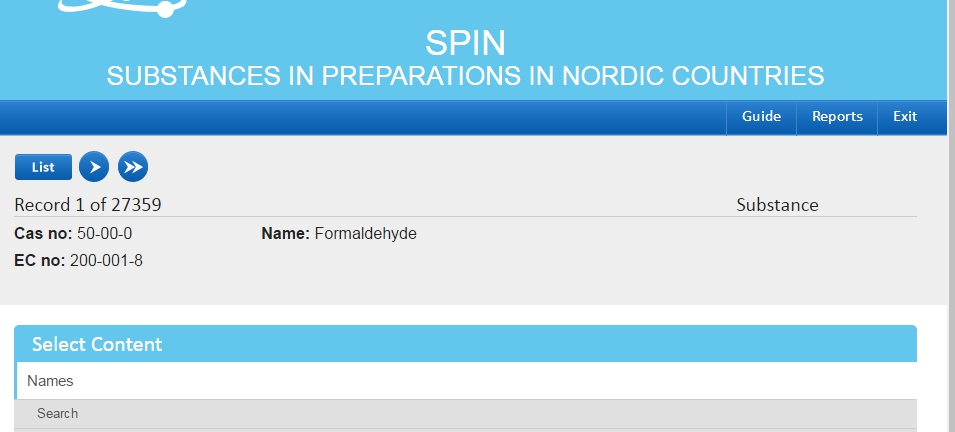
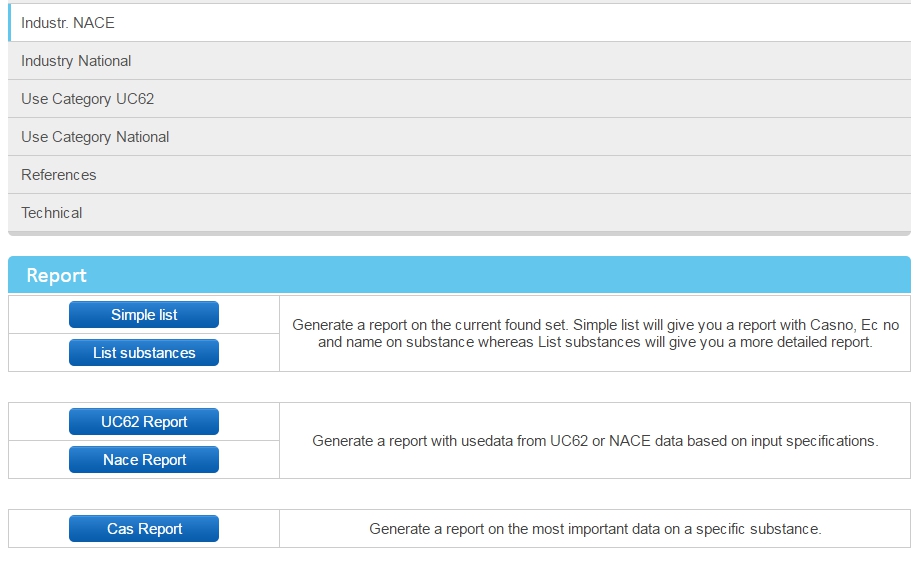
When you press the “Find” button after country, year and branch code have been selected, the substances are listed with the higher volumes first. Please note that if the total volume of a substance equals “0,0”, it only means that it is below the limit of accuracy, which is 100 kg.
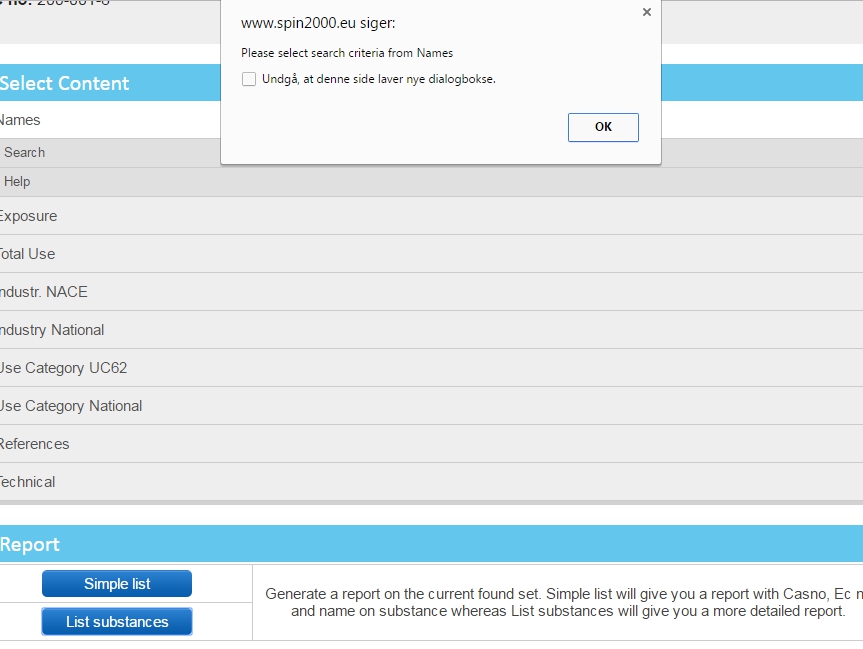
If you press the button “Return from report” you will return to the report window. If you press the “Print report” button, a preview of the printed report will appear. From here you can either print the report on paper, or you can save it as a file using the standard web features. Pressing the “New search” button resets the report and new parameters can be selected.
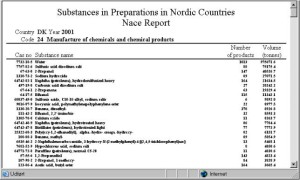
1.6.3 Reports – using the current found set
1.6.3 Reports – using the current found set
When you have found a specific set of records by searching as described in the sections 1.3.1, 1.3.2, 1.3.3 and 1.3.4 you can run the reports “Simple List” and “List Substances” from the report window on the basis of your current found set.
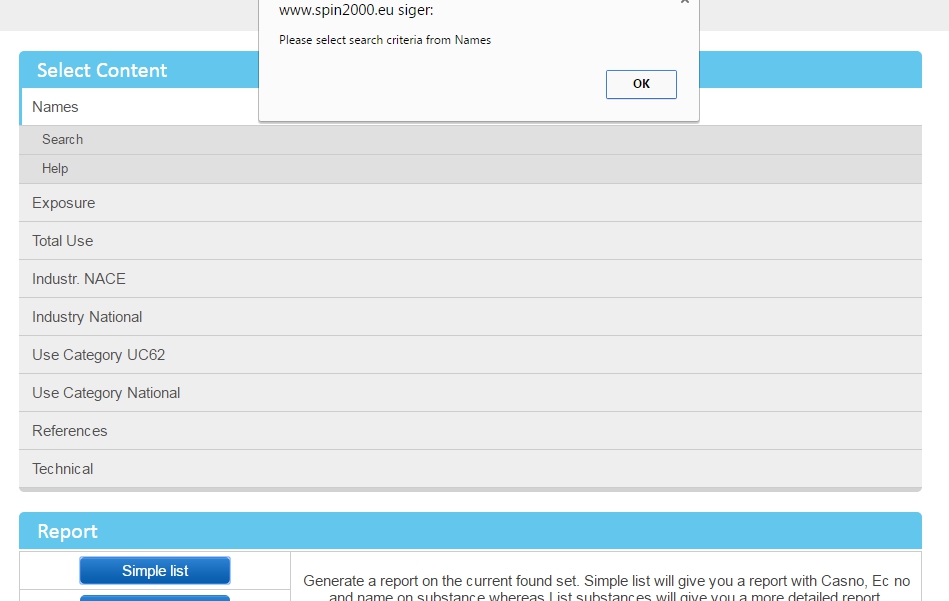
Pressing the “Simple List” button gives you a list of the substances in your current set identified by their CAS-No., EC-No. and name. You can either print the report on paper, or you can save it as a file using the standard web features.
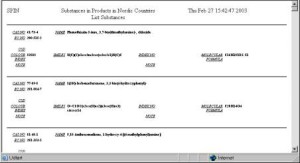
Pressing the ” List Substances ” button gives you a report of all the “technical” information about the substances in your current set. These are CAS-No., EC-No., CSD, C.I.-No., name, SMILES, Index-No. and molecular formula. To learn more about these substance data, please refer to section “1.6.6 On-line help – Technical”. If there are empty fields in some of the technical data fields in the “Substance data” report it is not because of error, but lack of data. Lots of substances do not have data in all of the listed fields. Again you can either print the report on paper, or you can save it as a file using the standard web features.
1.6.2 UC62 Report
1.6.2 UC62 Report
For a selected Nordic country and year, the UC62 Report gives you an overview of the total volume of each specific substance and the total number of preparations containing this substance in a selected category of technical function (use category) of the preparations containing the substance. Country, year and use category are selected from drop down menus in the top of the report before the “find” button is pressed. The use categories that are used follows the UC62 system as described in section “1.6.4 On-line help – Use by category”.
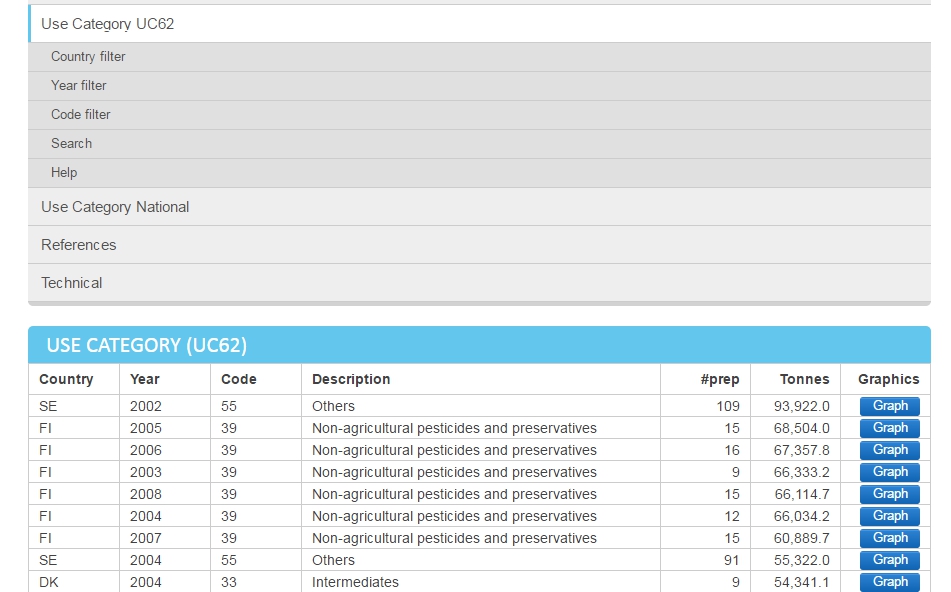
When you press the “Find” button after country, year and UC62 code have been selected, the substances are listed with the higher volumes first. Please note that if the total volume of a substance equals “0,0”, it only means that it is below the limit of accuracy, which is 100 kg.
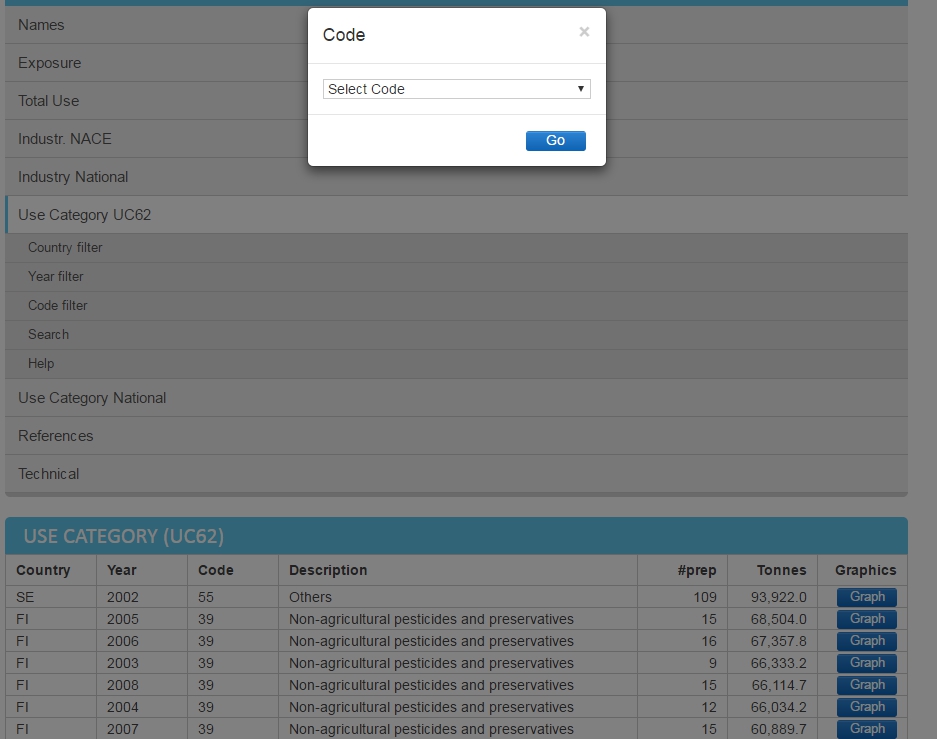
If you press the button “Return from report” you will be returned to the report window. If you press the “Print report” button, a preview of the printed report will appear. From here you can either print the report on paper, or you can save it as a file using the standard web features. Pressing the “New search” button resets the report and new parameters can be selected.
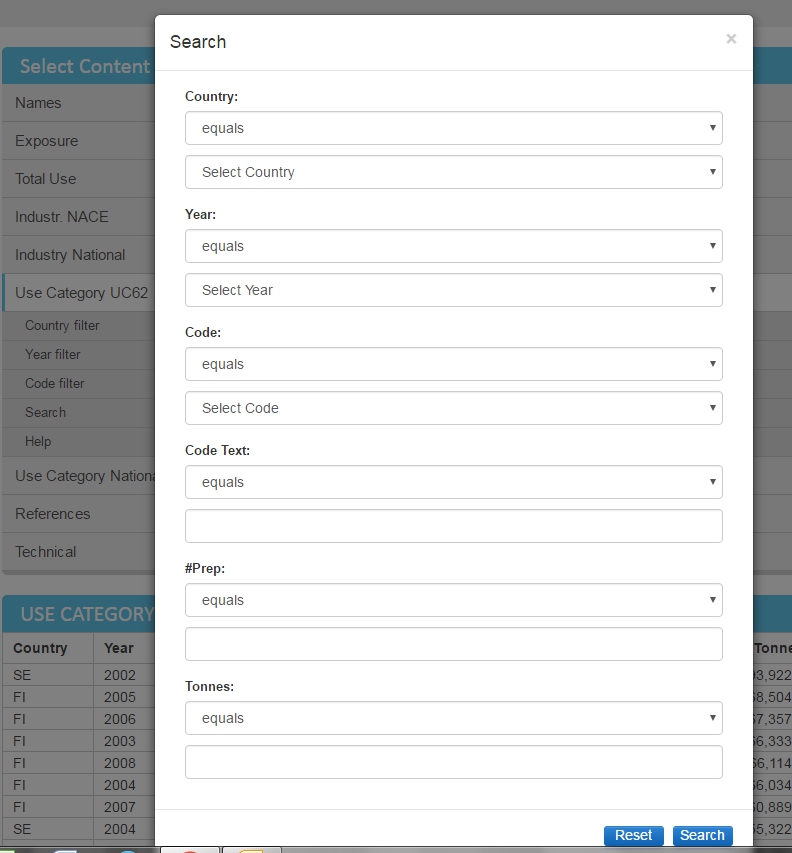
1.6 Reports in SPIN
1.6 Reports in SPIN
In the header of the report window the “List” and “Show All” buttons works in the same way as described in section “1.3.1 Searching in SPIN”. Pressing the “Guide” button opens the guide window and pushing the “Exit” button finishes the session and closes down the SPIN application. If you want to return to one of the information tabs, you simply press the title of the tab that you want to return to.

In the report window you can choose between 4 different reports. To activate a certain report you simply press the button with the report title. You must however perform a search (see the sections 1.3.1, 1.3.2, 1.3.3 and 1.3.4) before being able to work with the reports “Simple List” and “List Substances”. This is not necessary, when you are only working with “Nace Report” and “UC62 Report”.
1.5.6 On-line help – Technical
1.5.6 On-line help – Technical
The tab called “Technical” includes all of the “technical” information about the substance.
Molecular formula:
The molecular formula summarises the number of different atoms in the substance molecule, shown by the atomic symbols and their different counts.
Index No.:
The Index No. is an identification number used for substances that are officially recognized as dangerous by the European Commission and are entered on the E.C. List of Dangerous Substances (Annex I of directive 67/548/EEC with later adjustments). In the case of 1,4-benzenediamine below, the substance is classified by the E.C. as a substance that is toxic for humans and very toxic for the environment with allergenic and eye irritating properties (T;R23/24/25 Xi;R36 R43 N;R50/53). Substances without Index No. are not yet recognized as dangerous by the E.C., but that does not necessarily mean that they are harmless. In cases like that, the dangerous properties has to be assessed by the supplier of the substance.

SMILES:
SMILES is an acronym, meaning Simplified Molecular Input Line Entry Specification. It represents a valence model of the substance molecule and can be interpreted by computer programs to make a drawing of the molecular structure or a model calculation of physical, chemical and/or dangerous properties. You can get drawings of molecular structures like that of 1,4-benzenediamine by pressing the “Show structure” button. This will bring you directly to a homepage where the structure is depicted.
Colour Index:
The Colour Index Number, often abbreviated as C.I.-No. or just C.I., is the identification number used in Colour Index, the handbook of pigments and dyes first published in 1925, now published on the web by the Society of Dyers and Colourists and the American Association of Textile Chemists and Colorists. Please note that not all pigments and dyes in SPIN have a C.I.-No., either because it has not been registered, or because it has not been assigned for reasons of confidentiality. You can learn more about Colour Index at the homepage http://www.colour-index.org
CSD:
CSD is an acronym, meaning Chemical Substances Definition. It is used in the European list of existing substances (EINECS) and in the E.C. List of Dangerous Substances to give a more detailed description of naturally or technically occurring mixtures of substances, such as oil fractions derived from crude oil and similar mixtures. An example could be the CSD for “Fuel oil No. 6” with the Index-No. 649-030-00-1 and the CAS-No. 68553-00-4. The CSD for this “substance” says: “A fuel oil with a minimum viscosity of 195 cSt and a maximum viscosity of 1950 cSt at 37,7 ° C”.
Substance category:
The substance category code is a code used by the Danish Product Register to describe the assumed technical function of the substance as a component of a preparation. You can see the full list of substance categories in “3.4 Substance categories (Danish)” in the SPIN guide.
Main category (IUCLID):
Categories of use pattern as recorded in the IUCLID database. IUCLID stands for International Uniform Chemical Information Database. The database has been developed with a view to fulfilling the requirements of Council Regulation (EEC) no. 793/93 on the evaluation and control of the risks of existing chemicals and is situated in ECB, Ispra. You can see the full list of main categories in “3.3 Main Category (IUCLID)” in the SPIN guide.
1.5.5 On-line help – References
1.5.5 On-line help – References
Where data are present, the tab “References” contains information about the chemical relations of the given substance and information about various official inventories that might include it.
Inventories:
If a given substance is included in an official inventory, e.g. the Danish inventory of carcinogenic substances, and the inventory is included in SPIN, then the code and title of the inventory will appear in the inventory list under the title “Inventories”. The inventories in SPIN will typically either be connected to regulation (as the Danish inventory of carcinogenic substances), science (substances with certain properties) or politics (as the Danish list of undesirable substances).
Components:
In many cases the name and a CAS-No. not only covers one specific substance, but a mixture or compound of different substances. This often proofs to be the case with polymers and isomeric mixtures, where the “substance” in reality is a sometimes inseparable mixture of substances resulting from a chemical reaction. In SPIN these “substances” are described by their chemical building blocks, the substances that reacted chemically to form the mixture, under the title “Components”. In the case below, the “substance” is propoxypropanol formed from the components 1,2-propanediol and 1-propanol.
References:

If the isomers of the “substance” are known they will be listed under the title “References”. In the case below there is only 1 isomer: 1-propoxy-2-propanol.
1.5.4 On-line help – Use by category
1.5.4 On-line help – Use by category
The tabs called “Use by category (UC62)” and “Use by Category” gives you an overview of the technical use of preparations that contains the selected substance. When you first enter the tabs, they will show you the data from all contributing countries distributed on all reported codes from all the reported years, respectively. By pressing one of the button-shaped headings “Country”, “Year” or “Code”, you can get a more specific view. To learn more about specific selection of “use data” please see “1.4.1 Selecting specific “use data” on the screens” in the SPIN guide.
Country:
The countries that has contributed to SPIN with data from their national product registers are:
- NO: Norway
- SE: Sweden
- DK: Denmark
- FI: Finland.
There are no product register data from Iceland.
Year:
Data are reported to SPIN on a yearly basis. The data reflects the current status of the technical types of preparations that contains the substance in that particular year in the reporting country.
Code:
In the “Use by category (UC62)” tab the technical function af the preparations containing the substance is described by a UC62 code (Use Code 62). The 62 different use categories of UC62 represents a development of the 55 use categories for substances in the context of directive 79/831/EEC, Notif 23/90 – rev 5. The original 55 use categories were made to be suitable for substances. The extension with 7 more categories makes UC62 suitable for preparations as well.

In the “Use by Category” tab the use of the preparations containing the substance are presented by national use categories for registration of technical functions of preparations. They usually operate on a more detailed level than the 2 digit code in the “Use by category (UC62)” tab. Therefore data that might be included in the overall presentation in the “Use by category (UC62)” tab might be partly or totally suppressed in the “Use by Category” tab due to confidentiality. To learn more about UC62 and the national use categories, please refer to section “3.1 Use categories” under the tab called “3. Codes” in the SPIN guide.
Please refer to section “2.11 Uncertainties” under the “2. General info” tab in the SPIN guide for further information about confidentiality.
# preparations:
Number of preparations is the total registered count of preparations containing the substance used in the particular technical types of preparations in the particular year in the reporting country.
Tonnes:
“Tonnes” represents the registered volume of the substance in the particular year used in the particular technical types of preparations in the reporting country. If the value is “0.0” it means that the volume is below the limit of accuracy, which is 100 kg.
The sum of “Use by category” volumes and the “Total use” volume (see section “1.6.2 Total use”) for a specific substance used in a specific country cannot be compared. Partly because a certain volume can be presented with more than one code, partly because the distribution on codes often results in a number of preparations below the limit of confidentiality, which means that code and volume cannot be presented.
Please note that there are no Finnish volumes from the years 1999 and 2000, because Finland cannot report information about volumes earlier than year 2001.
1.5.3 On-line help – Industrial use
1.5.3 On-line help – Industrial use
The tabs called “Industrial use (NACE)” and “Industrial Use” gives you an overview of the industrial use of the selected substance. When you first enter the tabs, they will show you the data from all contributing countries distributed on all reported codes from all the reported years, respectively. By pressing one of the button-shaped headings “Country”, “Year” or “Code”, you can get a more specific view. To learn more about specific selection of “use data” please see “1.4.1 Selecting specific “use data” on the screens” in the SPIN guide.
Country:
The countries that has contributed to SPIN with data from their national product registers are:
- NO: Norway
- SE: Sweden
- DK: Denmark
- FI: Finland.
There are no product register data from Iceland.
Year:
Data are reported to SPIN on a yearly basis. The data reflects the current status of the industrial use of the substance in that particular year in the reporting country.

Code:
The industrial code used in the tab “Industrial use (NACE)” is the same for all the reporting countries. All the Nordic product registers use the NACE code, which is the statistical classification of economic activities in the European Community, that is also embodied in the EEA Agreement by the EFTA countries. The NACE codes indicate the branches of industry where the products are used. In the “Industrial use (NACE)” tab the NACE code is used at a 2-digit level to ensure, that not too many data has to be suppressed due to confidentiality.
In the “Industrial use” tab national industry groups based on NACE are presented. They usually operate on a more detailed level than the 2 digit code in the “Industrial use (NACE)” tab. Therefore data that might be included in the overall presentation in the “Industrial use (NACE)” tab might be partly or totally suppressed in the “Industrial Use” tab due to confidentiality. To learn more about the national industry groups, please refer to section “3.2 Industrial Categories” under the tab called “3. Codes” in the SPIN guide.
Please refer to section “2.11 Uncertainties” under the “2. General info” tab in the SPIN guide for further information about confidentiality.
# preparations:
Number of preparations is the total registered count of preparations containing the substance used in the particular part of industry in the particular year in the reporting country.
Tonnes:
“Tonnes” represents the registered volume of the substance in the particular year used in the particular part of industry in the reporting country. If the value is “0.0” it means that the volume is below the limit of accuracy, which is 100 kg.
The sum of “Industrial use” volumes and the “Total use” volume (see section “1.6.2 Total use”) for a specific substance used in a specific country cannot be compared. Partly because a certain volume can be presented with more than one code, partly because the distribution on codes often results in a number of preparations below the limit of confidentiality, which means that code and volume cannot be presented.
Please note that there are no Finnish volumes from the years 1999 and 2000, because Finland cannot report information about volumes earlier than year 2001.
1.5.2 On-line help – Total use
1.5.2 On-line help – Total use
The tab called “Total use” gives you an overview of the total use of the selected substance. When you first enter the tab, it will show you the data from all contributing countries from all the reported years, respectively. By pressing one of the button-shaped headings “Country” or “Year”, you can get a more specific view. To learn more about specific selection of “use data” please see section “1.4.1 Selecting specific “use data” on the screens” in the SPIN guide.
Country:
The countries that has contributed to SPIN with data from their national product registers are:
- NO: Norway
- SE: Sweden
- DK: Denmark
- FI: Finland.
There are no product register data from Iceland.
Year:
Data are reported to SPIN on a yearly basis. The data reflects the current status of the substance in that particular year in the reporting country.
# preparations:
Number of preparations is the total registered count of preparations containing the substance in the particular year in the reporting country.
Tonnes:
“Tonnes” represents the total registered volume of the substance in the particular year in the reporting country. The volume is calculated as production volume + imported volume – exported volume. If the value is “0.0” it means that the volume is below the limit of accuracy, which is 100 kg. If the value is negative, the exported volume exceeds the total of production and import volumes in the year in question.

Please note that there are no Finnish volumes from the years 1999 and 2000, because Finland cannot report information about volumes earlier than year 2001.
Consumer preparations:
An “X” in this column marks that the substance is registered in preparations for consumer use. Only Sweden has the ability of reporting this kind of information.
Confidential:
A “Yes” in this column marks that data are not available for reasons of confidentiality. Generally, data are kept confidential if the substance is a component in less than 4 preparations from less than 3 producers. Please refer to section “2.11 Uncertainties” under the “2. General info” tab in the SPIN guide for further information about confidentiality.
If the field is blank and #preparations and Tonnes are blank too, the substance has no data from the particular year in the reporting country. This is the case for substances which are reference substances or components in other substances. Please refer to section “1.6.5 On-line help – References” in the SPIN guide for further explanation.
1.5.1 On-line help – Main Info
1.5.1 On-line help – Main Info
The tab called “Main info” contains the most important information for substance identification, but to make navigation in SPIN easier, the CAS-name, the CAS-No. and the EC-No. of the substance are repeated on all tabs.
CAS-No.:
Since 1907, Chemical Abstract Service, CAS, has indexed and summarized chemistry-related articles from more than 40,000 scientific journals, in addition to patents, conference proceedings and other documents pertinent to chemistry, life sciences and many other fields. In total, abstracts for more than 21 million documents are accessible online through CAS.
When a chemical substance is newly encountered in the literature processed by CAS, its molecular structure diagram, systematic chemical name, molecular formula, and other identifying information are added to the CAS Registry and assigned a unique CAS Registry Number, the CAS-No. The CAS Registry contains records for more than 20 million organic and inorganic substances and more than 23 million sequences.
CAS Registry Numbers are used in reference works, databases, and regulatory compliance documents by many organizations around the world to identify substances without the ambiguity of chemical nomenclature.
You can learn more about the Chemical Abstract Service at the homepage http://www.cas.org
EC-No.:
The EC-number is created by the European Commission and is used to arrange the substances used within the E.C. among 3 regulatory lists. Numbers in the interval 200-001-8 – 310-312-1 comes from EINECS (European Inventory of Existing Commercial Chemical Substances), numbers in the interval 400-010-9 – 499-999-8 comes from ELINCS (European List of Notified Chemical Substances) and numbers in the interval 500-001-0 – 599-999-9 comes from NLP (No Longer Polymers). In general it is not legal within the E.C. to use a substance that has no EC-No. in a commercial product, unless the substance is a polymer.
You can learn more about the legislation concerning new chemicals at the homepage http://ecb.jrc.it/new-chemicals

Names:
This section contains chemical names with different name codes:
- The name next to “CAS” is the preferred chemical name from the Chemical Abstract Service Registry, the CAS-name.
- The name next to “PRN” is the preferred Norwegian chemical name.
- The name next to “PRD” is the preferred Danish chemical name.
- The name next to “FIN” is the preferred Finnish chemical name.
There are no specially preferred names in SPIN from Sweden and Iceland.
Administrators note:
The database administrator of SPIN can add a special note about the substance in this section. The data cannot be updated by ordinary users.
















